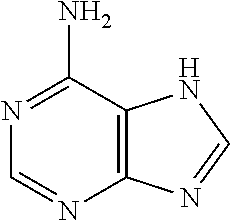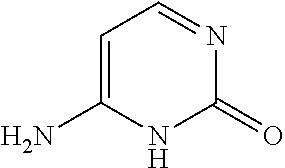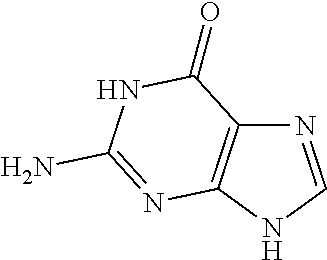Nucleic acid nanoparticles and uses therefor
a technology of nucleic acid and nanoparticles, which is applied in the field of nucleic acid nanoparticles and uses therefor, can solve the problems of inability to achieve the effect of enhancing the delivery to the site, affecting the biological activity of the agent, and causing unfavorable immune system reactions, etc., and achieves the effect of not impairing the biological activity of the nucleic acid, simple use, and enhanced delivery
- Summary
- Abstract
- Description
- Claims
- Application Information
AI Technical Summary
Benefits of technology
Problems solved by technology
Method used
Image
Examples
example 1
Adenosine Nanoparticle Formulation
[0218]Adenosine is a nucleotide that is known to have biological activity on skin structures (Brown et al., 2000, J. Investig. Dermatol., 115:849). An adenosine nanoparticle composition was prepared by forming a nanoemulsion. Briefly, 800 gm of 1349 medium chain triglyceride oil and 800 gm of TWEEN® 80 were stirred in a sterile vial for 5 minutes. 14 mg of adenosine (in 84 ml water) was added to the oil-TWEEN® mixture and stirred for 20 minutes. The sample was homogenized for 1 minute and then stirred for 20 minutes. The sample was microfluidized one time at 23,000 psi.
[0219]The resulting adenosine nanoemulsion was evaluated for particle size using the Malvern Nano S particle sizer capable of sizing particles between about 0.6 nm-6 μm. The nanoparticles formed were an average size of 75.9 nm in diameter. The nanoparticles had an average zeta potential of −12.9 mV.
[0220]The resulting nanoemulsion comprises a population of particles, and characteristi...
example 2
Phosphorylated Thymidine Dinucelotide (pTT) Nanoparticle Formulation
[0221]Phosphorylated thymidine dinucleotide (pTT) is known to have biological activity on skin structures (Goukassian et al., 2004, Proc. Natl. Acad. Sci., USA, 101:3933; Arad et al., 2006, FASEB J., 20:1895; Yaar et al., 2007, Breast Cancer Res., 9:R13; and Goukassian et al., 2002, FASEB J., 16:754). For example, pTT stimulates melanocyte production to result in tanning of the skin or to achieve the appearance of tanning of the skin, a biological effect that can be assayed and measured visually.
[0222]A pTT nanoparticle composition is prepared by forming a nanoemulsion. Briefly, 800 mg of soybean oil and / or 1349 oil and 800 mg of TWEEN® 80 are stirred in a sterile vial for 5 minutes. 1 mg of pTT (in 8.4 ml water) is added to the oil-TWEEN® mixture and stirred for 20 minutes. The sample is homogenized for 1 minute and then stirred for 20 minutes. The sample is microfluidized one time at 23,000 psi.
[0223]The resulting...
example 3
Skin Darkening Effects on Mice through Transdermal Application of a Nucleotide Nanoparticle
[0224]This example demonstrates the biological efficacy on the skin of transdermal application of a nucleotide nanoparticle composition.
Methods
[0225]A nucleotide nanoemulsion prepared in accordance with Example 2 is mixed with an equal volume of a skin cream (i.e., Base PCCA Vanishing Cream Light) and then vortexed into a uniform cream to generate the “Treatment Cream.”
[0226]A “Non-Nano Treatment Cream” is prepared by mixing the same amount of nucleotide into the same amount of water as Example 2 and then vortexing with the same amount of skin cream as is used to prepare the Treatment Cream. The Non-Nano Treatment Cream comprises all of the same components of the Treatment cream, but the preparation is not subjected to high shear force and, therefore, does not form a nanoemulsion. In contrast to the Treatment Cream, which is a nanoemulsion comprising a particular set of ingredients, the Non-Na...
PUM
| Property | Measurement | Unit |
|---|---|---|
| diameters | aaaaa | aaaaa |
| diameters | aaaaa | aaaaa |
| diameters | aaaaa | aaaaa |
Abstract
Description
Claims
Application Information
 Login to View More
Login to View More - R&D
- Intellectual Property
- Life Sciences
- Materials
- Tech Scout
- Unparalleled Data Quality
- Higher Quality Content
- 60% Fewer Hallucinations
Browse by: Latest US Patents, China's latest patents, Technical Efficacy Thesaurus, Application Domain, Technology Topic, Popular Technical Reports.
© 2025 PatSnap. All rights reserved.Legal|Privacy policy|Modern Slavery Act Transparency Statement|Sitemap|About US| Contact US: help@patsnap.com



